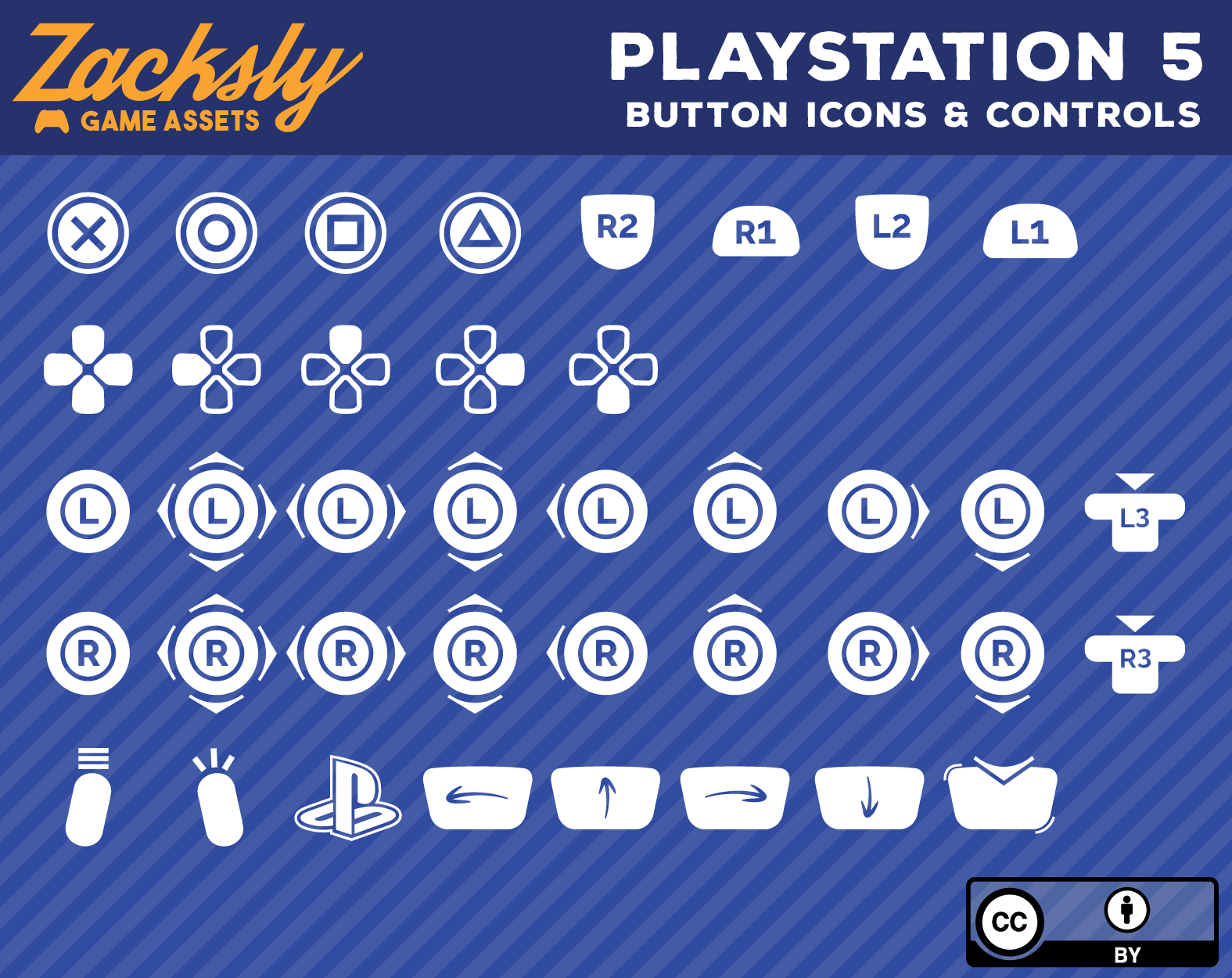Have you ever wondered what the L3 button on your PS5 controller does? This small yet mighty button is more than just a part of your gaming setup. Whether you're a seasoned gamer or just starting out, understanding the L3 button can elevate your gaming experience to the next level. The L3 button, located on the left thumbstick of your PS5 controller, is a versatile tool that serves multiple functions in various games. In this article, we'll explore everything you need to know about the L3 button on PS5 controller, from its basic functions to advanced techniques.
The L3 button on PS5 controller plays a crucial role in modern gaming. As gaming technology advances, controllers have become more sophisticated, offering players greater control and immersion. The L3 button, along with its counterpart R3, represents an evolution in gaming input that allows for more complex and nuanced gameplay. Understanding how to effectively use this button can significantly impact your gaming performance and enjoyment.
In this comprehensive guide, we'll delve deep into the world of the L3 button on PS5 controller. We'll cover its basic functions, advanced techniques, troubleshooting tips, and much more. Whether you're looking to improve your gaming skills or simply want to understand your controller better, this article will provide you with valuable insights and practical information. So, let's embark on this journey to master the L3 button and enhance your gaming experience.
Read also:Movierulz 2023 Ndash Download Movies Online Safely And Legally
Table of Contents
Understanding the L3 Button on PS5 Controller
The L3 button on PS5 controller is an integral part of Sony's DualSense wireless controller design. To fully appreciate its functionality, it's essential to understand its physical placement and technical specifications. Located on the left thumbstick, the L3 button is activated when you press down on the thumbstick itself. This design choice allows for seamless integration of movement and action commands, creating a more intuitive gaming experience.
Technically speaking, the L3 button on PS5 controller operates through a pressure-sensitive mechanism that registers input when sufficient force is applied to the thumbstick. This mechanism is designed to respond quickly and accurately, ensuring minimal input lag during gameplay. The button's placement and functionality are the result of extensive research and development, aiming to provide gamers with optimal control and comfort during extended gaming sessions.
Compared to its predecessor in the PS4 controller, the L3 button on PS5 controller has undergone several improvements. These include enhanced sensitivity, better durability, and more precise input recognition. The DualSense controller's advanced haptic feedback system also works in tandem with the L3 button, providing tactile responses that enhance the overall gaming experience. This evolution in controller design reflects Sony's commitment to pushing the boundaries of interactive entertainment.
Basic Functions of L3 Button on PS3 Controller
The L3 button on PS5 controller serves several fundamental purposes across various gaming genres. One of its most common uses is for character movement and perspective control. In first-person and third-person games, pressing the L3 button typically enables sprinting or running, allowing players to move their characters quickly across the game environment. This function is particularly useful in action-adventure games and battle royale titles where speed and agility can be crucial for success.
Another primary function of the L3 button on PS5 controller is camera control. Many games utilize the L3 button to toggle between different camera modes or to reset the camera position. This feature is especially valuable in open-world games where maintaining proper orientation is essential for navigation and situational awareness. The button's placement on the thumbstick makes it easily accessible while maintaining control over movement, creating a more fluid gaming experience.
Here are some common basic functions of the L3 button across different game genres:
Read also:Dafne Keen The Rising Star In Hollywood
- Action Games: Sprinting, quick dodging, or special movement abilities
- Adventure Games: Camera reset, zoom functions, or environmental interactions
- Sports Games: Player acceleration, special moves, or strategic positioning
- Racing Games: View changes, cockpit view toggling, or special maneuvers
Game-Specific Examples
In popular titles like "Spider-Man: Miles Morales," the L3 button on PS5 controller is used for web-swinging acceleration, allowing players to build momentum while traversing the city. Meanwhile, in "Demon's Souls," pressing the L3 button enables quick dodging, a crucial mechanic for avoiding enemy attacks. These examples demonstrate how developers utilize the L3 button to enhance gameplay mechanics and provide players with more dynamic control options.
Advanced Techniques and Uses of L3 Button
While the basic functions of the L3 button on PS5 controller are essential, mastering advanced techniques can significantly enhance your gaming performance. One such technique is the "L3 cancellation" method, commonly used in fighting games and action titles. This technique involves quickly pressing and releasing the L3 button to cancel animations or reset character states, allowing for faster combo execution or more precise positioning.
Another advanced application of the L3 button on PS5 controller is in implementing "movement techs" or "tech runs." These techniques combine L3 presses with other inputs to create more efficient movement patterns. For instance, in platformers, timing L3 presses with jumps can enable longer leaps or more precise landings. In first-person shooters, quick L3 presses can be combined with strafing movements to create unpredictable patterns that are difficult for opponents to track.
Professional Gaming Techniques
Professional gamers often utilize the L3 button in combination with other inputs to execute complex maneuvers. Here are some examples:
- Wall-running: In games like "Titanfall 2," the L3 button is used in conjunction with wall-running mechanics to maintain momentum and traverse vertical spaces efficiently.
- Quick-turns: Many FPS players use rapid L3 presses to execute 180-degree turns quickly, helping them respond to threats from behind.
- Combo extensions: Fighting game enthusiasts use precise L3 timing to extend combos beyond their normal limits, often catching opponents off guard.
These advanced techniques require practice and precision but can provide significant advantages in competitive gaming scenarios. The L3 button on PS5 controller, when mastered, becomes a powerful tool for executing these sophisticated maneuvers with accuracy and speed.
Game-Specific Applications of L3 Button
The versatility of the L3 button on PS5 controller becomes particularly evident when examining its application across different gaming titles. Each game utilizes the button's functionality in unique ways that complement its gameplay mechanics. Understanding these specific applications can help players optimize their performance and fully appreciate the depth of game design.
Popular Game Examples
In "Horizon Forbidden West," the L3 button serves multiple purposes depending on the context. During exploration, it enables Aloy to sprint, crucial for traversing the vast open world efficiently. When aiming with a weapon, the L3 button toggles between different aiming modes, allowing for precise targeting of mechanical creatures. The button's dual functionality demonstrates how developers can create intuitive control schemes that adapt to different gameplay situations.
For racing enthusiasts, "Gran Turismo 7" utilizes the L3 button on PS5 controller to enhance the driving experience. Players can use it to toggle between different camera views, including cockpit and bumper perspectives. Additionally, in certain driving modes, the L3 button activates special maneuvers or assists, helping players navigate challenging corners with greater precision. This implementation showcases how the L3 button can be adapted for genre-specific mechanics.
Table: L3 Button Functions in Popular PS5 Titles
| Game Title | Primary L3 Function | Secondary L3 Function | Special Features |
|---|---|---|---|
| Spider-Man: Miles Morales | Web-swinging acceleration | Quick camera reset | Enhanced swing mechanics with DualSense feedback |
| Demon's Souls | Quick dodge | Camera reset | Haptic feedback for different surfaces |
| Ratchet & Clank: Rift Apart | Sprint | Dimensional shift activation | Adaptive trigger integration |
| Returnal | Dash movement | Combat roll | Special combat techniques |
| Gran Turismo 7 | Camera view toggle | Special maneuvers | Realistic driving assists |
Troubleshooting Common Issues with L3 Button
Despite its robust design, the L3 button on PS5 controller can occasionally experience issues that may affect gameplay performance. Understanding these common problems and their solutions is crucial for maintaining optimal controller functionality. One frequent issue players encounter is the "sticky L3" problem, where the button feels unresponsive or requires excessive force to activate. This can be particularly frustrating during fast-paced gameplay moments that require quick reflexes.
Another common concern is the "drifting" phenomenon, where the L3 button appears to register inputs even when not pressed. This issue can lead to unintended character movements or actions within games, potentially causing disadvantages in competitive scenarios. Additionally, some users report reduced sensitivity or delayed response times from their L3 button, which can impact precision-based gameplay elements.
Solutions and Maintenance Tips
- Controller Calibration: Use the built-in calibration tool in PS5 settings to reset your controller's input sensitivity.
- Cleaning: Regularly clean the thumbstick area with compressed air to remove dust and debris that might affect performance.
- Software Updates: Ensure your PS5 system software and game patches are up-to-date, as these often include controller performance improvements.
- Rest Position: When not in use, store your controller with the thumbsticks in their neutral position to prevent stress on the internal components.
For persistent issues, contacting Sony's customer support or visiting an authorized repair center is recommended. They can perform more advanced diagnostics and, if necessary, replace faulty components. Remember that proper maintenance and care can significantly extend the lifespan of your PS5 controller and ensure the L3 button continues to function optimally.
Maintenance and Care Tips for L3 Button
Proper maintenance of the L3 button on PS5 controller is essential for ensuring long-term performance and reliability. The thumbstick mechanism, including the L3 button, is one of the most frequently used components of the controller, making it particularly susceptible to wear and tear. Implementing a regular maintenance routine can help prevent common issues and extend the lifespan of your controller.
One of the most important maintenance practices is regular cleaning. Use compressed air to remove dust and debris from around the thumbstick area every two to three weeks. For deeper cleaning, a cotton swab lightly dampened with isopropyl alcohol can be used to clean the base of the thumbstick. Be careful not to use excessive liquid, as moisture can damage internal components. After cleaning, allow the controller to dry completely before use.
Advanced Maintenance Techniques
For enthusiasts who want to take their controller maintenance to the next level, consider these advanced techniques:
- Lubrication: Apply a small amount of specialized controller lubricant to the thumbstick mechanism every six months to ensure smooth operation.
- Disassembly: Learn how to safely disassemble your controller to access and clean internal components. This should be done carefully and infrequently.
- Protective Measures: Use a controller skin or grip to reduce direct contact with the thumbsticks and prevent excessive wear.
Regularly check for firmware updates for your PS5 controller, as these often include performance improvements and bug fixes that can enhance

